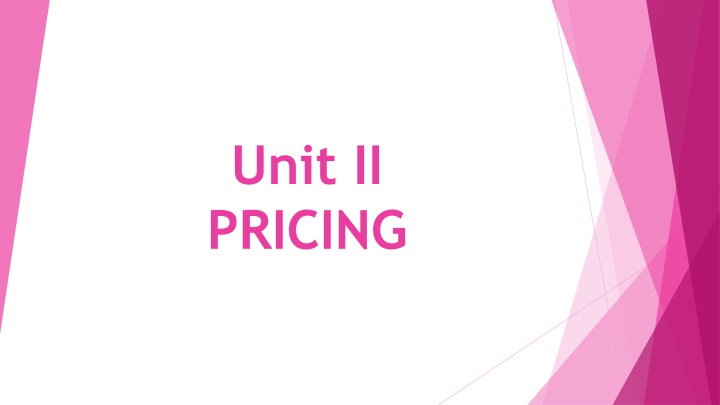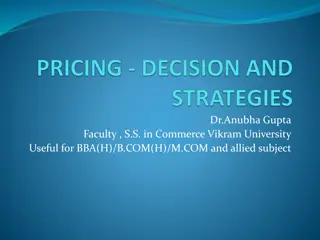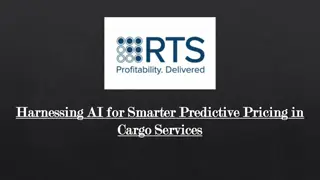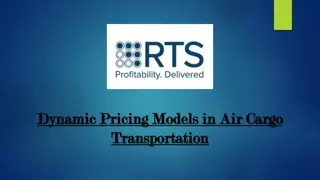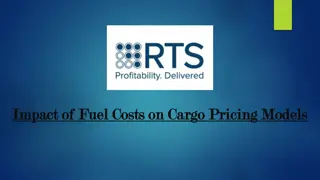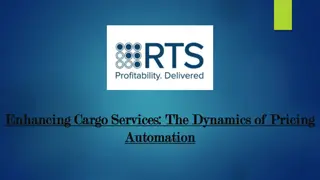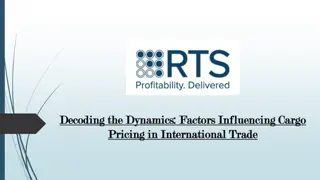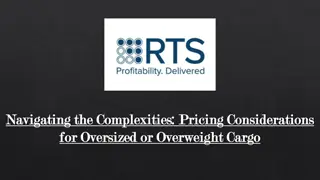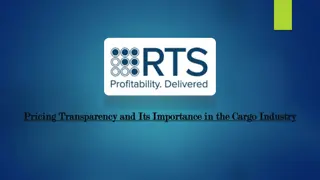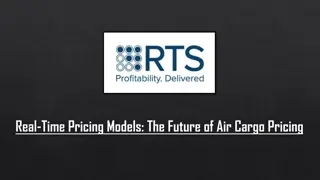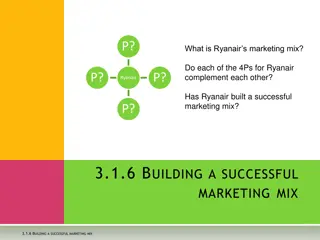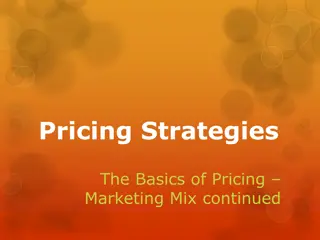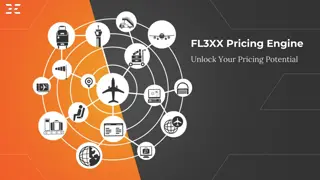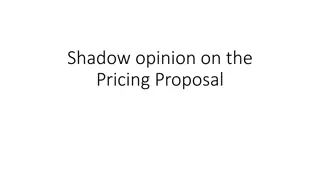Importance and Factors Influencing Pricing in Marketing
Pricing plays a vital role in marketing by regulating demand, determining profitability, and facilitating consumer support. Factors influencing pricing include marketing mix strategy, costs, market nature, demand levels, and competition dynamics.
Download Presentation

Please find below an Image/Link to download the presentation.
The content on the website is provided AS IS for your information and personal use only. It may not be sold, licensed, or shared on other websites without obtaining consent from the author.If you encounter any issues during the download, it is possible that the publisher has removed the file from their server.
You are allowed to download the files provided on this website for personal or commercial use, subject to the condition that they are used lawfully. All files are the property of their respective owners.
The content on the website is provided AS IS for your information and personal use only. It may not be sold, licensed, or shared on other websites without obtaining consent from the author.
E N D
Presentation Transcript
Unit II PRICING
CONCEPT & MEANING OF PRICING The concept of product pricing is very significant and plays a decisive role in the field of marketing A manufacturer has to take pricing decision before bringing the product in the market The market demand, consumer support, margin of profit, ability to face competition etc. are related to and dependent on the pricing It acts as a base for buying and selling transactions. It facilitates transfer of ownership and possession of goods and services from producers to consumers. Price means the expression of value or utility in terms of money. In other words pricing means fixing the market price of a commodity or service.
IMPORTANCE OF PRICING 1. Pricing act as a demand regulator and controls the demand for the products of the company. 2. It acts as a major tool for determining profitability of a firm. 3. Price can be used as sales promotion technique by offering discount and other incentives to consumers and dealers. 4. Fair and attractive pricing facilitates consumer support, large scale sales, quick turnover and high profits. 5. Majority of the companies formulate their marketing strategy taking price as a base. 6. Pricing policy can be used effectively for adjusting with the market changes or changes in the policies of competitors.
Factors influencing pricing 1. Marketing Mix Strategy: Price of a product or service is highly influenced by other elements of marketing mix. The product life cycle through which the product is passing through affects the price of the product. In the introductory product life cycle, the price is likely to be high. The channels of Distribution, location of warehousing and the transportation involved also influence the price determination. Promotion efforts reflect into final price. The amount of money spent by particular company reflect in the prices to be charged. If the intermediaries are to undertake promotion work, they will be charged a lower price and vice versa.
2. Costs: Cost of a product is the single most important factor to influence the final price. If the cost of a product is very high, then the price of a product would also be high and vice versa. 3. Nature of the market and demand: What is the expectation of the market about the product or services? What is the demand level for the product at different prices? If the market is monopoly, company can charge high price for their product but if the market is perfectly competitive, company has to decide the price by taking into consideration its competitors price Company also has to consider demand for the product at different prices. It has to fix the selling price of his products in such a way that there will be demand for its products and at the same time their profit margin should not be affected.
4. Competition: There might be pure competition (Many buyers and Sellers Who Have Little Effect on the Price), Monopolistic Competition (Many Buyers and Sellers Who Trade over a Range of Prices), Oligopolistic Competition (Few Sellers Who Are Sensitive to Each Other s Pricing/ Marketing Strategies), or Pure Monopoly (Single Seller). In each situation price determination will be different. 5. Willingness to Pay: Consumers wish whether to buy the particular product or not also affects the pricing policy of the company. If the price is very high consumer will not prefer to buy the product and vice versa. 6. Substitutes available in the market: If substitutes are available in the market, companies have to consider the prices of substitutes before determining the price of their products. If the company charged high price for their product which has a substitute in the market; there will be no demand for companies product.
Major Pricing Methods 1) Cost Based Pricing 2) Demand Based Pricing 3) Competition Based Pricing
Cost Based Pricing Pricing is based on the cost of production. The cost of manufacturing a product serves as the base of price fixation There are different types of costs such as fixed cost, variable cost, total cost, average cost and marginal cost, etc. An analytical study of these costs must be made for determining the market price of a product. For pricing purpose, the concept of total cost is used. Every manufacturer will like to cover the cost of production and some margin of profit from the price charged to consumers There will be loss to the manufacturer if the cost of production is not covered in the price charged. When the company adds expected profit to the cost of production; this pricing method is also called as cost plus or target pricing method. Cost based pricing provides the floor below which any sale would mean loss to the company. Hence cost based price is also called as floor price .
Under cost based pricing methods, there are different methods of determining price on the basis of cost. They are: 1. Cost plus pricing method 2. Marginal cost or incremental cost pricing method 3. Break even point or B.E.P. pricing method 4. Rate of Return or Target Pricing Method 5. Below cost pricing method
1. Cost plus pricing method: The cost plus pricing means fixing the price of one unit of product equal to the total cost per unit plus the desired profit on the unit. - 2. Marginal cost or incremental cost pricing method: Marginal cost is the increase in total costs resulting from producing one additional unit of a product or service. - 3. Break even point or B.E.P. pricing method: Break even point pricing is the practice of setting price point at which a business will earn zero profits on a sale. -
4. Rate of Return or Target Pricing Method: Target pricing is a method wherein the firm determines the price on the basis of a target rate of return on the investment i.e. what the firm expects from the investment made in the business. - Target pricing = unit cost + (desired return x invested capital)/ unit sales - 5. Below cost pricing method: Selling below cost is a practice whereby a firm sells products at less than costs of manufacture in order to drive out competitors and/or to increase market share. -
Advantages of cost based pricing 1) Simplicity: Cost based pricing is a simple and easy method of pricing. Unlike demand, cost is more certain, stable and comparatively easy to estimate. 2) Socially fair: - Cost based pricing is socially fair. It does not take advantage of the rising demand. - Many public sector companies in India use cost based pricing method. - 3) Safety: Cost based pricing is safe for the company as it guarantees recovery of cost of production from the price charged - It does not allow the company to play with seasonal or cyclical shifts in demands 4) Competitive Harmony: - There is greater competitive harmony and less of price wars amongst competitors when all units in the industry base their prices more or less on similar cost and add uniform mark-up -
Limitations of cost based pricing 1. This method ignore demand and the price elasticity of demand 2. It also ignores the competitive situation i.e. what competitor are charging for their products. 3. Does not take advantage of market potential. For eg. If a product is new and innovative such as iPad; when it was introduced company has a potential to charge a high price. 4. The consumer is likely to suffer as the manufacturer will calculate the cost of production and recover the cost from the consumers. He will not make any efforts to reduce the cost of production. 5. It is not suitable in highly competitive market.
2. Demand Based Pricing: In order to overcome the weakness of cost based pricing, the other alternative is to determine product price on demand basis Here the manufacturing company, does mot consider the production cost but allows market demand to determine price. The basic feature of this method is that profits can be expected independent of the costs involved, but are dependent on the market demand The demand for a product may be less or substantial or may be growing rapidly due to consumer support to the product Under this method, the price will be adjusted as per the demand to the product. Here the manufacturer will charge high price when there is high market demand and vice versa.
Methods under Demand Based Pricing: 1. What the Traffic Can Bear Pricing: Here the seller charges the maximum price which the customers are willing to pay for the product under the given circumstances. - The price needs to be fixed as per customers ability to pay and not necessarily as per the cost of production. - This pricing is useful in the case of personal services. - For eg. Advocates may charge fees as per the ability of their clients. - This is not sophisticated pricing method and it is normally used by retailers than manufacturers to earn high profits in the short run. -
2. Skimming Pricing: Here the manufacturer will charge high price when there is a high market demand and when the demand for the product reduces, he will reduce the market price accordingly. - 3. Penetration Pricing: Under this method manufacturer will charge less price initially and will raise it as per the growing market demand. -
Advantages and Disadvantage of Demand Based Pricing Method Advantages: 1. The demand based pricing penalise inefficiency, optimise product mix and facilitates new product pricing. 2. Demand based pricing may lead to potential high profit. Disadvantages: 1. It does not ensure competitive harmony and it is not safe for the company 2. This pricing is not socially fair because change in demand for the product exploits the consumers. 3. Management must be able to estimate demand at different levels, which may be difficult to do accurately.
3. Competition Based Pricing Under competition based pricing method, the price is based on what its competitors are charging for similar products. It is a method of pricing in which attempts to maintain its price more or less on par with the prices charged by its competitors irrespective of its own cost and demand situations are made. Competition based pricing does not mean exactly matching competition but due consideration should be given to competition factor. If market competition is not duly considered before determining the prices of products, marketing objectives of the enterprise may not be achieved.
It is convenient when market is highly competitive and products are homogeneous and not capable of differentiation as regards quality, uses, benefits etc. This pricing method also called as Parity pricing or Going rate pricing. For such pricing, company collects required information from the market and adjust the price accordingly. When price is decided exclusively on the basis of competition, the company cannot unilaterally increase or decrease the price. If the company unilaterally increase or decrease the price, not necessary that competitors also increase or decrease their prices
Pricing Methods under Competition Based Pricing 1) Premium pricing 2) Discount pricing 3) Parity or going rate pricing
1. Premium pricing: Premium pricing refers to pricing above the level adopted by competitors - 2. Discount pricing: Discount pricing refers to pricing below the level adopted by competitors. - 3.Parity or Going Rate Pricing: Firm prices its products at the same level as that of the competitors. - It assumes that there will be no price wars within the industry - This pricing method used by new enterprises or by the enterprises introducing a new product in the market - It is also used for determining the price of products facing very tough competition in the market. - This method is used on the assumption that new product can creates its demand only when its price is competitive. -
Advantages of competition based pricing: 1.It prevents price wars and avoids the problems of manufacturers due to severe market competition. Disadvantages of competition based pricing: 1. It is not necessarily true that all firms or the leader firm is operating efficiently. In case it is not, it will mean that the follower firm will also adopt a price level which reflects leaders inefficiency. 2. It is not always true that a decision taken in collective wisdom is the best. It may not be so from competitors point of view.
PRICING POLICIES Pricing policies are guidelines within which a company has to administer prices so as to match them with the market needs. Such policy guidelines are framed by the top level management and the policy is executed by the marketing department of the company. A sound price policy enables a company to raise its turnover and profitability. Price fixation is complicated as various factors and forces such as production cost, market demand, market competition, etc. need careful consideration while determining the market price of a product. Price policy need not be rigid. It should be adjustable as per the changing needs of marketing environment Pricing which is appropriate during the introductory stage of product life cycle may prove unsuitable during the other stage of product life cycle. This suggests the need of introducing appropriate pricing policies.
1. Skimming Pricing Under this policy, a manufacturer charges very high price in the initial period (much higher than the cost of production), when the product is new, attractive and required by many consumers. In due course, the price will be brought down because of the reduction in demand or due to the entry of other competitors in the market. The essence of skimming the cream pricing policy is to charge high price in the initial period and to reduce it gradually as per market situation demand. It enables the manufacturer to have more profit out of the initial demand. He can recover a part of his investment from the high profit made in the initial period. Skimming pricing is appropriate in the case of fashionable goods introduced for the first time in the market
Suitability: 1. When the product is completely new and the initial demand is likely to be substantial. 2. When the initial cost of production is high and naturally a high market price is necessary. 3. When the producer desires to cover the possible future loss which may result from the entry of new competitors in the market shortly. 4. If the producer has incurred huge expenditure on research and development activities, he will certainly like to recover his investment by charging higher price initially. 5. Where the products are of specialty goods such as fashion-oriented goods. 6. Where the price and quality relationships are viewed favorably. High prices imply high quality for quality conscious customers. 7. Where the exporter wants to skim the cream before competitors enter the market. 8. If a limited supply exists, the company may follow a skimming approach to match demand and supply. 9. Where a company wants to maximize its revenue. 10. Where the segment of the market is willing to pay a premium price for the value received.
Advantages of Skimming pricing 1. High profit margin: The entire point of price skimming is to generate an outsized profit margin. - 2. Cost recovery: If a company competes in a market where the product life span is short , price skimming may be the only viable method available for ensuring that it recovers the cost of developing products. - 3. Dealer profits: If the price of a product is high, then the percentage earned by distributors will also be high, which makes them happy to carry the product. - 4. Quality image: A company can use this strategy to build a high-quality image for its products, but it must deliver a high-quality product to support the image created by the price. -
Disadvantages of Skimming pricing 1. Competition: There will be a continual stream of competitors challenging the seller's extreme price point with lower-priced offerings. 2. Sales volume: - A company that uses price skimming is limiting its sales, which means that it cannot lower costs by building sales volume. 3. Consumer acceptance: - If the price point remains very high for too long, it may defer or entirely prevent acceptance of the product by the general market. 4. Annoyed customers: - Early adopters of the product may be highly annoyed when the company later drops its price for the product, thereby generating bad publicity and a very low level of customer loyalty. 5. Cost inefficiency: - The very high profit margins engendered by this strategy may cause a company to avoid making the cost cuts required to keep it competitive when it eventually lowers its prices. -
Penetration Pricing Penetration pricing policy is just opposite to skimming the cream pricing policy. Under this policy, a low price (near to the cost of production) is charged initially in order to create popularity to the product among customers through initial low price. The penetration pricing strategy is used in order to attract more customers and to make the customer switch from current brands existing in the market. The main target group is price sensitive customers. Once a market share is captured, the prices are increased by the company.
Suitability: When consumers are willing to accept the new product as their regular requirement. This means the demand is likely to grow quickly. When the price elasticity of demand for the product is high over a short period. When the producer desires to adopt long term marketing policy in which he wants to create substantial demand in the initial period. It is popular among reputed business units. The potential competitors are not eager to enter the market by charging low price for the product in the initial period.
Advantages of Penetration Pricing: 1. An attraction is created in the minds of the consumers and they are encouraged to purchase the product. 2. A greater volume of sale is possible by charging low price. 3. The competitors are discouraged from entering the field because of low margin of profit 4. This policy is useful for capturing the market. Thus, market penetration pricing is a long term pricing and gives good results. 5. Happy at having struck a profitable deal, the customers are ready to come back to the manufacturer in future. This goodwill created also leads to further promotion of the product through "word of mouth". 6. The emphasis on keeping the price low helps in controlling the cost thereby cost efficiency is achieved.
Disadvantages of Penetration Pricing: 1. The customer expects the prices to remain low for a long term. They are not ready for the subsequent rise in the price and when it happens they might switch to a competitor's product. Thus subsequent price hike leads to loss of market share gained. 2. It is believed that penetration pricing cannot create strong customer relationship and only attracts customers on the lookout for a profitable deal. 3. Low price may not yield sufficient profit to cover up expenses in short run. 4. The price and quality relationships may bear adverse implications. A lower price may be related to low quality of the product. 5. Once a low price is quoted, it is difficult to rise it later. 6. If the product has a short life cycle and goes out of date within a short period, the loss suffered by the marketer will be huge.
3. Geographical/Geographic Pricing: These pricing policies are applicable mainly to exports undertaken by a marketing firm. It involves variations of prices depending on the location where the product and service is being sold In this pricing, a seller considers the costs of shipping goods to the buyer. An example of geographic pricing can be the sales of heavy machinery, which are sold after considering the transportation cost of different locations.
Geographic pricing policies include the following: 1. Point of origin or point of production pricing: Here the seller quotes the selling price at the point of production and the buyer selects the mode of transportation and pays all freight costs. - Seller does not pay any of the freight costs. He pays only for loading the shipment abroad the freight carrier. - Seller charges the same amount on each sale of similar quantities; only the delivery price varies according to the freight cost payable by the buyer. -
2. Freight Absorption Pricing: To penetrate distant market, a manufacturer/seller may be willing to share a part of the freight cost. In this pricing policy, a manufacturer will quote to the customer, a delivered price equal to its factory price plus the freight costs that would be charged by a competitive seller located near that buyer/customer. A freight-absorption pricing policy is adopted to offset competitive disadvantage when trying to sell to buyer located in markets near competitors plants. A nearby supplier has an advantage over more distant suppliers in regard to freight costs. Freight absorption erases any price advantage due to differences in freight costs. A seller can use this pricing policy to expand its market as long as its net revenue after freight absorption is larger than its marginal costs for units sold. - - - - - -
3. Uniform Delivered Price: Under uniform delivered pricing, the same delivered price is quoted to all buyers irrespective of their locations. - This pricing policy is used where freight costs are small part of the seller s total costs. - Under this pricing, the net revenue to the seller varies depending on the freight cost involved in each sale transaction - Buyers near the seller s factory pay some of the costs of shipping to more distant locations. - It is used by the retailers who believe free delivery as an additional service that strengthen their market position. -
4. Zonal-Delivered Price/Pricing: Zonal delivered pricing divides a seller s market into a limited number of broad geographic zones and then sets a uniform delivered price for each zone. - 5. Base Point Price Policies: Base point price policy involves partial absorption of the transport cost by the company - Here the price is quoted by incorporating transport cost computed up to the buyers location by reference to one geographical location called the base point. - This base point is not necessarily the factory. It can be the nearest to the buyer s location. - Buyers pay ex-factory price plus freight computed from the nearest base point irrespective of the actual freight incurred by the company. - The base point decided by the company may be single or multiple. -
4. Leader Price Policy/Follow the Leader Pricing Under leader pricing policy, small/small scale manufacturers in one line of marketing adjust their pricing policy as per the pricing policy of a leading manufacturer or leader manufacturer. For eg. In soap manufacturing in India, Hindustan Lever is a leading manufacturer. So most of the small soap manufacturing companies adjust their pricing policy as per Hindustan Lever. Small producers have to follow this pricing policy in order to minimise market competition due to price difference. Secondly it is difficult for them to follow independent pricing policy even when cost of production may not be same. Such policy is useful particularly when the products are identical and the market is dominated by one leader manufacturer. It is basically a protective policy which fails to give special advantages to small manufacturers but it gives fair opportunity of survival to them even if the market competition is severe.
5. Psychological Price Policy: Psychological pricing policy is based on the psychology of consumers. Here a consumer is led to believe that he is paying less than what actually he should. The purpose is to give psychological relief to consumers while paying the price. In a highly competitive marketing, psychological pricing is useful for promoting sales. Such policy is suitable in the case of consumer goods such as footwear, cosmetics and other items of daily use. In psychological price policy, the price fixed may be like Rs.299 or Rs.999. Here the buyer gets a feeling that he is paying less than Rs.300 or Rs.1000. Bata Shoe company is known for psychological pricing.
